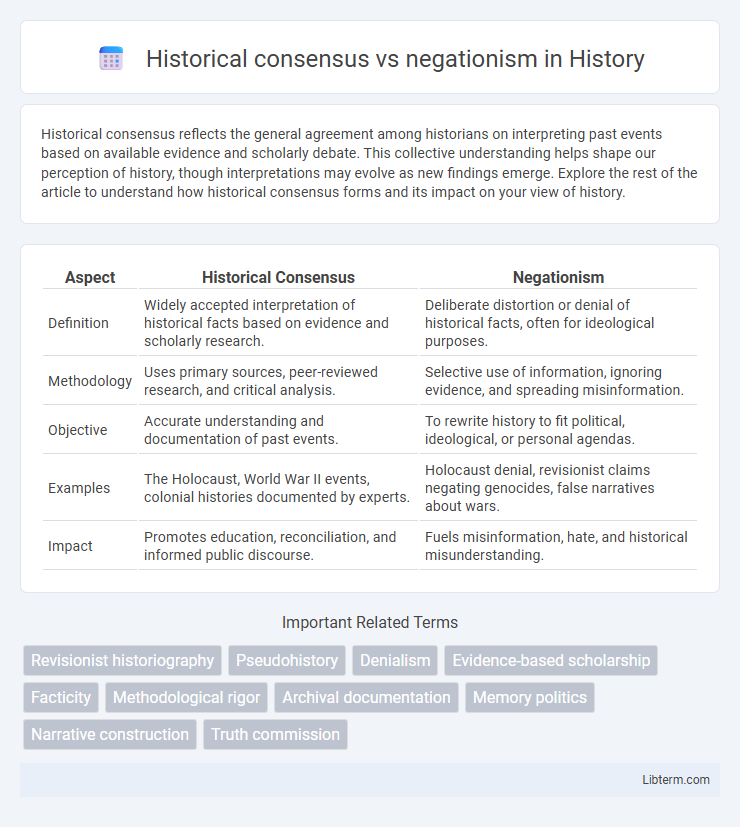Historical consensus reflects the general agreement among historians on interpreting past events based on available evidence and scholarly debate. This collective understanding helps shape our perception of history, though interpretations may evolve as new findings emerge. Explore the rest of the article to understand how historical consensus forms and its impact on your view of history.
Table of Comparison
| Aspect | Historical Consensus | Negationism |
|---|---|---|
| Definition | Widely accepted interpretation of historical facts based on evidence and scholarly research. | Deliberate distortion or denial of historical facts, often for ideological purposes. |
| Methodology | Uses primary sources, peer-reviewed research, and critical analysis. | Selective use of information, ignoring evidence, and spreading misinformation. |
| Objective | Accurate understanding and documentation of past events. | To rewrite history to fit political, ideological, or personal agendas. |
| Examples | The Holocaust, World War II events, colonial histories documented by experts. | Holocaust denial, revisionist claims negating genocides, false narratives about wars. |
| Impact | Promotes education, reconciliation, and informed public discourse. | Fuels misinformation, hate, and historical misunderstanding. |
Defining Historical Consensus
Historical consensus refers to the widely accepted interpretations and understandings of past events established through rigorous analysis of primary sources, archaeological evidence, and scholarly peer review. It embodies a collective agreement among reputable historians based on methodological rigor and evidentiary support, distinguishing legitimate historical research from speculative or revisionist narratives. This consensus serves as a benchmark for evaluating the credibility of historical claims and combats negationism, which seeks to distort or deny established facts for ideological purposes.
Understanding Negationism
Understanding negationism involves recognizing the deliberate distortion or denial of historical facts, particularly concerning events such as genocides, wars, or authoritarian regimes. This practice undermines historical consensus established through rigorous research, primary sources, and scholarly agreement while promoting misinformation and ideological agendas. Effective counteraction requires critical analysis, education, and the preservation of credible records to uphold accurate collective memory.
Origins and Evolution of Historical Consensus
The origins of historical consensus trace back to the collective agreement among scholars based on rigorous analysis of primary sources and established methodologies, forming a unified narrative that is continually refined through new evidence and scholarly debate. Historical consensus evolves as historians critically evaluate differing perspectives, ensuring a balance between continuity and revisionism while highlighting the importance of evidence-based interpretations over ideological distortions. This process underscores the dynamic nature of historiography, distinguishing well-supported consensus from negationism, which rejects or distorts established facts often for political or ideological motives.
Motivations Behind Negationism
Negationism often stems from political or ideological motivations aimed at reshaping collective memory to serve nationalistic or revisionist agendas, undermining established facts about events like genocides or wars. Economic interests may also drive negationism by protecting reputations of influential groups or avoiding reparations. Psychological factors such as cognitive dissonance contribute as individuals or societies reject uncomfortable truths to preserve identity and social cohesion.
Methodologies: Evidence vs. Denial
Historical consensus relies on rigorous methodologies, including critical analysis of primary sources, corroboration of evidence, and peer-reviewed research to establish verified narratives. Negationism often employs selective denial, distortion of facts, and omission of corroborated evidence to undermine established historical truths. The stark contrast between evidence-based historiography and denialist tactics highlights the importance of methodological integrity in preserving accurate historical understanding.
Impact of Negationism on Society
Negationism undermines historical consensus by distorting factual events and spreading misinformation, which erodes public trust in educational and governmental institutions. The impact on society includes fostering division, perpetuating stereotypes, and hindering reconciliation processes among communities affected by historical atrocities. Such denialism obstructs efforts to learn from the past, increasing the risk of repeating similar injustices and conflicts.
Case Studies: Famous Instances of Negationism
Historical consensus relies on a comprehensive evaluation of evidence and scholarly agreement to present an accurate portrayal of events, while negationism involves deliberate distortion or denial of established facts. Famous instances of negationism include Holocaust denial, Armenian Genocide denial, and the denial of atrocities committed during Stalin's regime in the Soviet Union. These cases highlight how negationism undermines historical truth, perpetuates misinformation, and impedes reconciliation and justice.
The Role of Historians in Upholding Consensus
Historians play a crucial role in upholding historical consensus by meticulously analyzing primary sources and corroborating evidence to present accurate narratives. Their commitment to rigorous methodology prevents the distortion of events and counters negationist agendas that seek to rewrite or deny established facts. Through peer-reviewed scholarship and public education, historians maintain the integrity of collective memory and promote informed understanding of historical realities.
Combating Historical Distortion
Combating historical distortion is essential to preserving the integrity of historical consensus, which relies on critical analysis of primary sources and scholarly peer review to establish accurate narratives. Efforts to counter negationism involve educational initiatives, fact-checking, and legal frameworks that challenge deliberate falsification or denial of well-documented events such as genocides or wars. Maintaining a clear distinction between legitimate historical revisionism and harmful negationism supports the collective memory and promotes informed public discourse.
The Future of Historical Memory
The future of historical memory hinges on balancing historical consensus, which relies on rigorous evidence and scholarly agreement, against negationism that distorts facts for ideological purposes. Advances in digital archiving and global communication promote widespread access to verified historical data, strengthening collective memory and resisting revisionist narratives. Educational frameworks integrating critical thinking and source evaluation play a crucial role in preserving authentic historical understanding amidst rising challenges from negationist efforts.
Historical consensus Infographic

 libterm.com
libterm.com